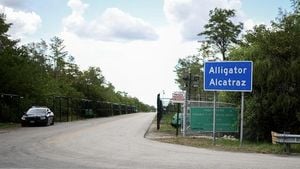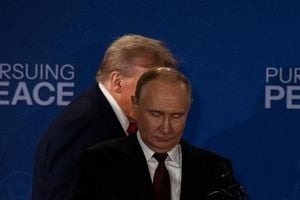Taiwan has taken a significant step in bolstering its defenses amid rising tensions with China by deploying its most advanced strike weapons, the High Mobility Artillery Rocket Systems (HIMARS), acquired from the United States. This move coincides with the island’s annual Han Kuang live-fire drills, which are now in full swing and are considered Taiwan’s most comprehensive military exercise.
On Saturday, July 12, 2025, two armored trucks equipped with HIMARS were spotted maneuvering around Taichung, a city near Taiwan’s central coast. The drills, now on their fourth day out of ten, are designed to simulate real combat scenarios and test Taiwan’s readiness against potential Chinese aggression. Military spokesperson Colonel Chen Lian-jia emphasized the critical need to conceal these rocket systems from enemy aerial reconnaissance, satellites, and even operatives behind Taiwanese lines until the command to fire is given.
China views Taiwan as a breakaway province and has long threatened to use force to bring the island under Beijing’s control. Over the past five years, Beijing has intensified military pressure through a series of war games and daily naval and air patrols encircling Taiwan. Earlier in the week, China’s Ministry of National Defense dismissed the Han Kuang drills as “nothing but a bluffing and self-deceiving trick,” while the Ministry of Foreign Affairs reiterated its “consistent and very firm” opposition to U.S.-Taiwan military ties.
Despite these dismissals, Taiwan’s President William Lai Ching-te stressed on July 10 that the exercises are “based on large-scale, realistic combat drills,” underscoring the seriousness with which Taipei is preparing for any potential conflict. The HIMARS units, which Taiwan started receiving in 2024, have a striking range of approximately 300 kilometers (190 miles), putting important coastal targets in China’s southern Fujian province within reach. This capability marks a notable enhancement in Taiwan’s deterrence strategy.
The Han Kuang drills are unscripted and designed to replicate full combat conditions, beginning with simulated enemy attacks and invasion scenarios. According to unnamed senior Taiwanese military officials quoted by Reuters, the exercises aim to demonstrate to both China and the international community, including the United States, Taiwan’s unwavering determination to defend itself against any Chinese attack.
Meanwhile, on the diplomatic and strategic front, the Pentagon is intensifying efforts to clarify the roles of its key allies in the event of a conflict over Taiwan. The Financial Times reported on the same day that Elbridge Colby, the U.S. under-secretary of defense for policy, has been urging Japan and Australia to define what part they would play if war were to break out between the U.S. and China over Taiwan. This request reportedly caught both Tokyo and Canberra off guard, particularly because the U.S. does not offer a blanket guarantee to defend Taiwan militarily.
Colby, who served as deputy assistant secretary of defense for strategy and force development during President Donald Trump’s first term, is known for advocating a strategic pivot that prioritizes competition with China over conflicts in the Middle East and Europe. His push for clarity from allies reflects growing concerns within the U.S. defense establishment about the complexities and risks of a potential Taiwan conflict.
While the U.S. remains Taiwan’s most important supplier of defensive weaponry, formal diplomatic ties between the two remain absent, complicating the political and military calculus. Taiwan continues to reject China’s sovereignty claims, insisting on its de facto independence. However, the increasing military pressure from Beijing, including frequent war games and patrols, has heightened the urgency for Taipei to shore up its defenses and for Washington to coordinate with regional partners.
The deployment of HIMARS and the ongoing Han Kuang drills send a clear message that Taiwan is not only aware of the threats it faces but is actively preparing to counter them. The combination of advanced weaponry and rigorous, realistic training exercises aims to deter Chinese aggression by demonstrating Taiwan’s capacity to respond effectively.
At the same time, the Pentagon’s engagement with Japan and Australia signals a broader strategic effort to build a united front in the Indo-Pacific region. Clarifying the roles of these allies is crucial, as any conflict over Taiwan would likely involve multiple countries and complex military coordination. Yet, the apparent surprise of Tokyo and Canberra at the Pentagon’s request highlights the delicate and uncertain nature of alliance commitments in this high-stakes geopolitical environment.
China’s dismissive stance toward Taiwan’s military exercises and its firm opposition to U.S.-Taiwan ties underscore the ongoing tension and the risk of miscalculation. Taiwan’s leadership, however, remains resolute. As President Lai stated, the exercises are not mere drills but “large-scale, realistic combat drills” designed to prepare the island for the worst-case scenario.
In essence, Taiwan’s deployment of HIMARS and the comprehensive Han Kuang drills represent a critical phase in its defense strategy amidst a shifting regional security landscape. Coupled with the U.S. push for allied clarity on potential conflict roles, these developments underscore the complexity and urgency of the Taiwan issue, which continues to be a flashpoint in U.S.-China relations and regional stability.
As the drills continue and diplomatic efforts unfold, the world watches closely, aware that the balance of power in the Indo-Pacific hangs in a delicate equilibrium shaped by military preparedness, strategic partnerships, and the resolve of Taiwan to defend its sovereignty.



